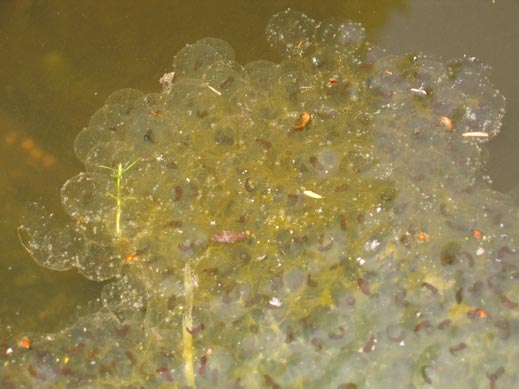From Full Stops to Commas – update on the Frog Blog 2010
Tadpoles are Developing – Frog Blog 2010
Not exactly the most wonderful spring weather at the moment, at least we have been able to avoid the heavy snow falls that affected parts of Scotland earlier this week. The patches of frogspawn in the pond are showing signs of development, well at least those clutches of eggs that are in the sunny shallows. Although, these clumps of spawn (we are not sure what the collective noun for frogspawn is), were some of the last to be laid, several days after the first frogspawn, they are developing more quickly.
The spawn that was laid first was moved out of the shallow water into slightly deeper water, this was as a result of all the frantic activity of the frogs. Two clumps of spawn have ended up in about 2 feet of water. The frogspawn can still be seen and as far as we can tell it is not developing as quickly as the frogspawn produced later but laid in the warmer, sunlit shallows.
Frog Blog
Tadpoles Developing in the Frogspawn

Picture credit: Everything Dinosaur
Tadpoles
The first frogspawn was laid around 20th March, this particular clump of spawn has been pushed into deeper water, whereas, the spawn laid towards the end of the mating period has remained in shallows and seems to be developing quicker. The picture above shows a clump of frogspawn in the shallows. Note that the black dots of the embryos are turning from a round “full stop” into a “comma” shape with a distinctive head and a tail. Movement can be detected in the clump of spawn as the tadpoles move inside their eggs. No signs of development can be seen in the spawn in the deeper part of the pond. We have suspected for sometime that egg development was related to water temperature. Those eggs exposed to direct sunlight in shallows will be warmed and therefore hatch quicker than their counterparts deeper in the pond. It is really a question of balance, perhaps the clump of spawn in the deeper water is protected from drying out and is less likely to predated upon by terrestrial based predators. The price paid for this is a slow start to the hatching process.

